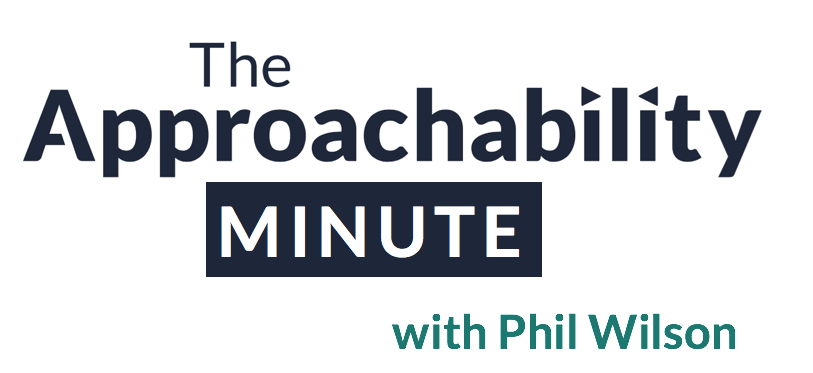
Social Distance Can Really Disrupt Your Work
One of the foundations of Approachable Leadership is the idea of “power distance” (click here to read how power distance destroyed Nokia). Power distance describes how different people react to people in power. Some are intimidated and defer to people in power, while others don’t seem too concerned.
We believe that shrinking this gap is essential to maintaining organizations that thrive, innovate, and develop employees.
Harvard professor, Tsedal Neeley, studies a very similar phenomenon called social distance. In a great HBR article she describes the problem of social distance in the workplace, Neeley explains why social distance, or “the degree of emotional connection among team members,” can create huge disruptions to the flow of healthy work environments. Neeley recommends ways to shrink social distance between different cultures (Hofstede’s power distance research focused on the same problem) in global companies. I believe her recommendations can be applied to any company, big or small, remote or not.
Neeley lays out 5 sources of social disruption with the acronym SPLIT:
- Structure
- Process
- Language
- Identity
- Technology
Structure and the Perception of Power
Neeley says, “to correct perceived power imbalances between different groups, a leader needs to get three key messages across:”
- Who we are. Despite differences in individual members of the team, it’s important that they all understand that the team is one entity. “The leader should encourage sensitivity to differences but look for ways to bridge them and build unity.”
- What we do. As all the individual members make up one whole, they all share one purpose. Leaders must remind the team of this and “direct their energy toward business-unit or corporate goals.”
- I am there for you. People need to feel that they have a connection with their leader, that they can rely on him or her.
Process and the Importance of Empathy
“It almost goes without saying that empathy helps reduce social distance. If colleagues can talk informally around a watercooler—whether about work or about personal matters—they are more likely to develop an empathy that helps them interact productively in more-formal contexts.”
The job of a leader here is to create “deliberate moments” that include:
Feedback on routine interactions. People often send the wrong signals without even realizing they’re doing it. These issues need to be brought to light in order to develop “reflected knowledge,” or “awareness of how others see us.” The more you are able to create a space where employees feel comfortable giving feedback to you or each other, the more this “reflected knowledge” will develop on its own in team members.
Unstructured time. Create and allow time for personal (non-work) interactions and communication. “Unstructured communication like this is positive, because it allows for the organic unfolding of processes that must occur in all business dealings—sharing knowledge, coordinating and monitoring interactions, and building relationships.”
Time to disagree. “Leaders should encourage disagreement both about the team’s tasks and about the process by which the tasks get done.” Neeley suggests framing these conversations as brainstorming sessions or meetings specifically to evaluate agenda items in order to “take the heat out of the debate.”
We here at Approachable Leadership are big believers in the importance of empathy for healthy relationships in life and at work. (Click here to learn more about how to be more empathetic using our Empathy Tool from our upcoming Approachability Playbook.)
Language and the Fluency Gap
“Good communication among coworkers drive effective knowledge sharing, decision making, coordination, and, ultimately, performance results.”
There are many causes for communication gaps among coworkers, but no matter the cause, the effects are the same. No “knowledge sharing” leads to poor “decision making,” lack of “coordination,” and reduced “performance results.” Neeley recommends mitigating these effects by focusing on the three rules when communicating as a group.
- Dial down dominance. Don’t let the strong people, or the ones with power complexes monopolize the meeting.
- Dial up engagement. Make a point to actively seek out contribution from all members of the team.
- Balance participation for inclusion. “Monitor participants and strive to balance their speaking and listening.”
Identity and the Mismatch of Perceptions
“Teams work most smoothly when members ‘get’ where their colleagues are coming from. However, deciphering someone’s identity and finding ways to relate is far from simple.”
How do you do it? You ask questions. And you encourage team members to ask questions.
“In this model, everyone is a teacher and a learner, which enables people to step out of their traditional roles. Team members take on more responsibility for the development of the team as a whole. Leaders learn to see themselves as unfinished and are thus more likely to adjust their style to reflect the team’s needs. They instruct but they also facilitate, helping team members to parse their observations and understand one another’s true identities.”
Check out our Approachability Window tool for more guidance on breaking down barriers and increasing communication and understanding.
Technology and the Connection Challenge
As we all know, “technologies can both reduce and increase social distance.” Emails can get misinterpreted. Video conferences, on the other hand, can allow people to see body language cues and better understand the emotions and feelings behind the words.
She suggests three questions you should always ask yourself when determining which kind of technology to use.
- Should communication be instant?
- Do I need to reinforce the message?
- Am I leading by example?
The most important here is number three.
“A leader who wants to encourage people to videoconference should communicate this way herself. If she wants employees to pick up the phone and speak to one another, she had better be a frequent user of the phone. And if she wants team members to respond quickly to e-mails, she needs to set the example.”
And this applies to more than just how you communicate through technology. Are you prompt at meetings? Do you follow through on your commitments? Do you invite feedback?
“To manage social distance effectively and maximize the talents and engagement of team members, leaders must stay attentive to all five of the SPLIT dimensions. Decisions about structure create opportunities for good process, which can mitigate difficulties caused by language differences and identity issues. If leaders act on all these fronts, while marshaling technology to improve communication among geographically dispersed colleagues, social distance is sure to shrink, not expand”
I really enjoyed this article. After all, it is a terrific run-down of many of the key things we teach in Approachable Leadership. However, it left me a little overwhelmed.Each of the SPLIT dimensions has several points to consider. This is a whole lot for a leader to think about. There is no doubt that doing any of these things will improve your leadership. But trying to remember it all might give you a headache 🙂
That’s why I suggest if you want to shrink social distance you start with one thing: Be more approachable. Do that and you will be well on your way to improving in all five of the SPLIT dimensions. And you’ll save some money on aspirin!
What do you think about the SPLIT dimensions? In your experience, is social distance a real problem in the workplace? What things do you do to shrink social distance? Let us know in the comments.

This weekend I subjected my wife and daughter to Batman v Superman. Critics are panning the movie, calling it dark, humorless, and too long. All true. I can pick out many things I would change. Instead let me tell you what I appreciated about it.
This is a big movie that tries to do a lot. Its overarching theme is how powerful people struggle with their power. It focuses on the power triangle of Batman, Superman and Lex Luthor (brilliantly played by Jesse Eisenberg – best villain since Heath Ledger’s Joker, IMHO).
I won’t spoil anything, but let’s just say everybody in the movie struggles mightily with their power (or perceived lack of it). Batman and Superman don’t act that heroic. Lex acts like the good guy (for a while). In the end everyone figures out which side they’re on. But the struggle to do what’s right, to use that power for good, really resonated.
Leadership is a lot like that struggle. You will face choices about how to use your power. Then you’ll have to figure out which side you are on. Sometimes you will be tempted to take the easy way out. You will take the low road, using the power of your position (“If you don’t like it I hear McDonalds is hiring”) instead of relying on the power of your relationship. Each time you choose that path you build momentum in the wrong direction – but choosing the positive path will often seem like a waste of time. Sometimes it will look like the worst move.
Alan Mulally and Positive Leadership
This all reminded me of a terrific article I read recently about Alan Mulally, former President and CEO of Ford. Mulally practiced something he called Positive Leadership (I’d call it Approachable Leadership). From the article:
On his first day as Ford’s CEO in 2006, Mulally asked to tour Ford’s famous Rouge plant where Henry Ford created the Model T. Mulally was informed by one of his top executives, “Our leaders don’t talk directly to factory employees.” Ignoring that advice, he went to the plant immediately to talk to front-line workers.
One of the first things Mulally did when he took over was redesign company meetings. He turned the meetings from negative (one observer called them “arenas for mortal combat”) to constructive. Mulally instituted a “traffic light” system where people would give a signal for their key initiatives. The Fortune article continues:
After four meetings in which all programs were labelled green, Mulally confronted his team, “We are going to lose $18 billion this year, so is there anything that’s not going well?” His question was met with stony silence.
The following week, Ford’s North American President, Mark Fields, showed a red indicator that a new vehicle launch would be delayed. Other executives assumed Fields would be fired over the bad news. Instead, Mulally began clapping and said, “Mark, that is great visibility.” He asked the group, “What can we do to help Mark out?” As he frequently told his leaders, “You have a problem; you are not the problem.”
That’s positive (and approachable) leadership. Positive Leadership is based on the idea of positive psychology, pioneered by psychologist Martin Seligman. Seligman says there are three aims of positive psychology:
- Building human strength
- Making the lives of people fulfilling
- Nurturing the talent that resides in all of us
Or as Mulally described it:
“Positive leadership – conveying the idea that there is always a way forward – is so important, because that is what you are here for – to figure out how to move the organization forward. Critical to doing that is reinforcing the idea that everyone is included. Everyone is part of the team and everyone’s contribution is respected, so everyone should participate.”
Mulally entered into an environment where Negative Leadership reigned supreme. Nobody thought his attempts to change the culture would succeed. I’m sure many scoffed behind closed doors when the traffic light idea was proposed. It took weeks for these high-powered execs to even dare present a red-light to the CEO, and only one had the guts to do it after the whole leadership team had been called out.
It can be hard to do the right thing as a leader. Often the right thing isn’t obvious. Sometimes it looks like the wrong thing. You have to make decisions based on core principles, like those of positive psychology. Build others, make their lives fulfilling, nurture their talent. That is a great place to start.
Eventually the dust will settle. I can’t guarantee that Wonder Woman will be there to help save the day, but the chances are good that you’ll get a sequel.
Questions: Have you ever struggled with your power as a leader? Have you ever taken the “low road” relying on your position more than your relationship? And most important: Are you more of a Superman or a Batman fan?

You disagree with your boss. How should you handle it?
Healthy disagreement among colleagues is completely normal and, in my opinion, critical to making a business as strong as it can be. But what if you disagree with your boss? The problem is that disagreements often present two types of holdups:
- Many people don’t know how to disagree and still be productive.
- Others are afraid to disagree with those in power positions (the boss).
Today I’ll focus on disagreeing with someone in a power position, but the advice applies to any relationship or disagreement. And if done correctly, you can disagree while finding productive solutions and bringing people closer rather than creating further distance.
Harvard Business Review recently covered how to disagree with your boss. They point to Joseph Grenny, coauthor of Crucial Conversations. When asked about why he thinks people shy away from speaking up to a superior when they disagree, Grenny said:
“Our bodies specialize in survival, so we have a natural bias to avoid situations that might harm us.”
I could not agree more. This is the “Flight or Fight” response, which is a big part of the behavioral and psychological research that Approachable Leadership is founded on (stay tuned for the upcoming release of The Approachable Leadership Playbook, where we dive into this idea even further).
As leaders, we have a responsibility to reduce the negative feelings our employees may have if they disagree with us. How can we do that?
- Invite opposing ideas. Ask for pushback. Leaders must make decisions, but as you and I both know, sometimes we just don’t know. We have to go with our gut or our best guess. When you find that you don’t feel strongly one way or another, open the floor for people to throw out some other ideas. The more you do this, the more you take away the stigma associated with disagreeing with the boss.
- Ask to be convinced. I do this one often. I’ll have my mind made up. I think I know what the right decision is, and then one brave employee speaks up. Even if their initial suggestion doesn’t move me much, I ask them to go into further detail – “Change my mind,” I’ll say. And you know what? Often, they do. To be a good leader you must want someone else’s idea to be the right idea. For many, this can be a challenge.
What about the flip side? Even bosses have bosses. And, let’s be honest, not all bosses receive opposing viewpoints well. So for those of you who don’t want to let someone else’s issue hold you back from truly investing in your organization and speaking your mind, here are 9 tips to disagree with your boss in a way that most allows your position to be heard (courtesy of HBR).
-
Be realistic about the risks. “Most people tend to overplay the risks involved in speaking up….consider ‘the risks of not speaking up’ – perhaps the project will be derailed or you’ll lose the teams trust – then realistically weigh those against the potential consequences of taking action.”
-
Decide whether to wait. “After the risk assessment, you may decide it’s best to hold off on voicing your opinion…It’s also a good idea to delay the conversation if you’re in a meeting or other public space. Discussing the issue in private will make the powerful person feel less threatened.”
-
Identify a shared goal. “Before you share your thoughts, think about what the powerful person cares about…You’re more likely to be heard if you can connect your disagreement to a ‘higher purpose.'”
-
Ask permission to disagree. “This step may sound overly deferential, but, according to Grenny, it’s a smart way to give the powerful person ‘psychological safety’ and control.” (Click here to read our article on psychological safety)
-
Stay calm. “You might feel your heart racing or your face turning red, but do whatever you can to remain neutral in both your words and actions. When your body language communicates reluctance or anxiety, it undercuts the message.”
-
Validate the original point. “After you’ve gotten permission, articulate the other person’s point of view. What is the idea, opinion, or proposal that you’re disagreeing with? Stating that clearly, possibly even better than your counterpart did, lays a strong foundation for the discussion.”
-
Don’t make judgements. “When you move on to expressing your concerns, watch your language carefully. Grenny says to avoid any ‘judgement words’ such as ‘short-sighted,’ ‘foolish,’ or ‘hasty’ that might set off your counterpart; one of his tips is to cut out all adjectives, since ‘they have the potential to be misinterpreted or taken personally.'”
-
Stay humble. “Emphasize that you’re offering your opinion, not ‘gospel truth,’ says Grenny. ‘It may be a well-informed, well-researched opinion, but it’s still an opinion, [so] talk tentatively and slightly understate your confidence'”
-
Acknowledge their authority. “Ultimately, the person in power is probably going to make the final decision, so acknowledge that…That will not only show you know your place but also remind them that they have choices, Grenny says. Don’t backtrack on your opinion or give false praise, though.”
Click here to read HBR’s full article on this topic.
What do you think about these ideas? As a leader, how do you handle disagreement? Do you think your employees feel like they can speak up to you? What about when you disagree with your boss? Do you have any other suggestions? We want to know!

Fast Company published an article last week detailing what makes a person “management material.”
After consulting a number of experts, they came up with these 6 traits:
- You’re good at building relationships. “You cannot be a leader unless people are willing to follow you…To have followers, you need to be skilled at developing and maintaining relationships.”
- You’re approachable. “Employees of approachable bosses are less likely to quit and more likely to engage in “above-and-beyond” behavior at work…If you’re approachable you’ll be a successful leader. If you’re unapproachable over the long run you will fail.”
- You look at the big picture. “To manage, you need to be able to see the big picture; how pieces of the organization fit together, and how a change in one area will affect another.”
- You think strategically. “You should understand the environment inside and outside of the organization…You need skills in problem identification and analysis, and must be able to generate and evaluate solutions.”
- You can check your ego at the door. “Focusing on leaving behind a better team than you found is important, but the leader needs to be comfortable with letting other people shine for this to work.”
- You have a proven track record of results. “When credibility, competence, and aspiration are all evident, the odds of the person successfully transitioning from an individual contributor into a management are greatly increased.”
We’ll let you guess which piece of advice was ours.
Do you have anything to add to this list? Or tips to help people develop these qualities? We’d love for you to share them with us!
















